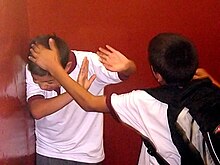Talk:Motivation and emotion/Book/2015/Extrinsic motivation and antisocial behaviour in children
Add topicPictures that may be relevant
[edit source]

Suggestions and Feedback
[edit source]Heading casing
[edit source]| FYI, the convention on Wikiversity is for lower-cased headings. For example, use:
==Cats and dogs== |
Chapter review and feedback
|
This chapter has been reviewed according to the marking criteria. Written feedback is provided below, plus there is a general feedback page. Please also check the chapter's page history to check for editing changes made whilst reviewing through the chapter. Responses to this feedback can be made by starting a new section below and/or contacting the reviewer. Chapter marks will be available later via Moodle, along with social contribution marks and feedback. Keep an eye on Announcements. |
 Overall[edit source]
|
-- Jtneill - Talk - c 15:00, 27 November 2015 (UTC)
Multimedia feedback
|
The accompanying multimedia presentation has been marked according to the marking criteria. Marks are available via the unit's Moodle site. Written feedback is provided below, plus see the general feedback page. Responses to this feedback can be made by starting a new section below. If you would like further clarification about the marking or feedback, contact the unit convener. |
Overall[edit source]
|
-- Jtneill - Talk - c 09:23, 2 December 2015 (UTC)
The Conflict Between Intrinsic and Extrinsic Motivators
[edit source](Hi, this is just a friendly edit, I found some information you might like to include. Thanks!)
Observation of any child for a long period of time will reinforce one thing – Children love to have new items in their possession. There doesn’t have to be a reason for a new item, but the mere fact it can happen and that it is new is the fairly safe stereotype. This fact is obviously quite common knowledge. Everybody was a child once. The reason why it’s crucial in this scenario however, is the conflict in children between extrinsic motivation and intrinsic motivation is stirred up by children wanting new things. As Deci, Koestner and Ryan (1999) have acknowledged, the conflict between extrinsic and intrinsic motivation is problematic in childhood. In adults it is hard at the best of times. Not because the purchasing of new possessions is expensive, but the fact that in order to appease children, we have become willing to buy their silence. This has become the norm, instead of working on their intrinsic level of self-satisfaction and happiness with what toys they already have (Ryan & Deci, 2000). In realisation of this problem, it is only going to be a matter of time before the child has achieved the task to acquire the new shiny object. The task each of us set out, despite knowledge of what was being done was bad. This is what children have been trained to do. Therefore, the proposal for a third motivation state seems the only viable option to support good parenting and the demands of children. Thus, the proposal for an in-between motivation state seems the only viable route to take. Whereby the fun and excitement of being able to succeed and be rewarded is balanced fairly with the opportunity to say no and to provide time for reflection and intrinsic personal growth (Benabou, 2003). Furthermore, the realisation that children, or adults, will never occupy just one state of motivation will be the greatest success.
Reference List
Benabou, R. (2003). Intrinsic and extrinsic motivation. Review of Economic Studies, 70, 489- 520. doi: 10.1111/1467-937X.00253
Deci, E. L., Koestner, R., & Ryan, R. M. A meta-analytic review of experiments examining the effects of extrinsic rewards on intrinsic motivation. Psychological Bulletin, 125, 627- 668.
Ryan, R. M., & Deci, E. L. (2000). Self-determination theory and the facilitation of intrinsic motivation, social development, and well-being. American Psychologist, 55, 68-78. doi: 10.1037/0003-066X.55.1.68
— Preceding unsigned comment added by Moyism (talk • contribs) 04:44, 14 December 2015 (UTC)


